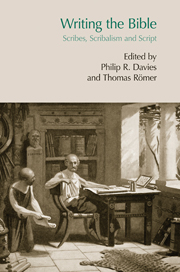Book contents
- Frontmatter
- Contents
- Abbreviations
- 1 Introduction
- I Writing in the ancient world
- II Hebrew Bible and early Judaism
- III Early Judaism and early Christianity
- 10 Some scribal features of the thematic commentaries from Qumran
- 11 Efficacious writing: the inscription of the rosette on the High Priest's forehead and the Egyptian reception of Exodus 28
- 12 The prose writer (συγγραφεύς) and the cultures of author and scribes: the examples of Galen and the anonymous author of Luke-Acts
- 13 Peter and his secretary in Pseudo-Clement
- 14 On the danger of writing according to Origen
- Index of biblical and other ancient sources
- Author index
11 - Efficacious writing: the inscription of the rosette on the High Priest's forehead and the Egyptian reception of Exodus 28
- Frontmatter
- Contents
- Abbreviations
- 1 Introduction
- I Writing in the ancient world
- II Hebrew Bible and early Judaism
- III Early Judaism and early Christianity
- 10 Some scribal features of the thematic commentaries from Qumran
- 11 Efficacious writing: the inscription of the rosette on the High Priest's forehead and the Egyptian reception of Exodus 28
- 12 The prose writer (συγγραφεύς) and the cultures of author and scribes: the examples of Galen and the anonymous author of Luke-Acts
- 13 Peter and his secretary in Pseudo-Clement
- 14 On the danger of writing according to Origen
- Index of biblical and other ancient sources
- Author index
Summary
THE POWER OF WRITING
“Writing” is a process (tracing signs that carry a meaning), but also the result of this process (the signs themselves). In this case, the palaeographer speaks of a “hand”, a word that refers to the scribe's art, not the writer's. A change of hand is nothing other than a change of scribe, something which might intervene even if the text continues fluently.
When the scribe is not the author of the copied text, s/he is simply a worker. But is “simple” an appropriate term? The scribe is a practitioner and his art possesses a share of prestige. Writing is said to be effective when it goes beyond the letter and its purely informative function. The written word can also establish real links—legal, commercial, social— between people.
The magical papyri are extreme examples of this phenomenon. The contract is tied by the very tracing of the words and when they are written in letters of gold or of orpiment (whose yellow colour evokes the luminous power of the metal) one understands that the contractual virtue of writing is essentially material (Étienne 2000: 46–9).
Runic inscriptions are thought to display such an intrinsic power. The angular ductus of the alphabet called futhark (from the names of the first six letters of the Norse alphabet; Boyer 1992: 618–23) is explained by the fact that the letters were designed to be only engraved and not written with a pen or a brush.
- Type
- Chapter
- Information
- Writing the BibleScribes, Scribalism and Script, pp. 144 - 158Publisher: Acumen PublishingPrint publication year: 2013



